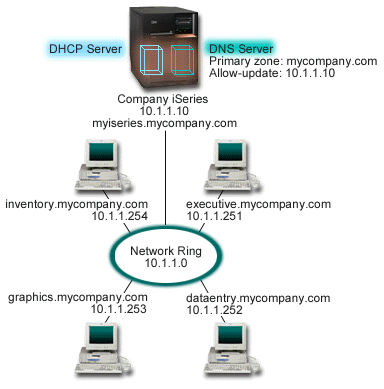You can learn how to set up the iSeries™ server as a DHCP server with dynamic DNS updates for a simple LAN.
Figure 1 illustrates how the iSeries server can act as a DHCP and DNS server for a simple subnet. In this work environment, suppose that the inventory, data entry, and executive clients create documents with graphics from the graphics file server. They connect to the graphics file server by a network drive to its host name.
Previous versions of DHCP and DNS were independent of each other. If DHCP assigned a new IP address to a client, the DNS records had to be manually updated by the administrator. In this example, if the graphics file server's IP address changes because it is assigned by DHCP, then its dependent clients are unable to map a network drive to its host name because the DNS records contain the file server's previous IP address.
With the new DNS server delivered in V5R1, you can dynamically update your DNS records in conjunction with intermittent address changes through DHCP. For example, when the graphics file server renews its lease and is assigned an IP address of 10.1.1.250 by the DHCP server, the associated DNS records are updated dynamically. This allows the other clients to query the DNS server for the graphics file server by its host name without interruption.
You can configure DHCP to update resource records on address mapping (A) records and reverse-lookup pointer (PTR) records on behalf of a client. The A record maps a client's host name to its IP address. The PTR record maps a client's IP address to its host name. For each record that is updated dynamically, an associated text (TXT) record will be written to identify that the record was written by DHCP. You can choose to allow DHCP to update both A and PTR records, or just PTR records. For more information about how to configure DNS to accept dynamic updates, refer to Example: DNS and DHCP on the same iSeries server in the DNS topic.
To enable DNS updates, you must create a DNS key for your DHCP server. The DNS key authorizes the DHCP server to update the DNS records based on IP addresses it has distributed. Then, in the DHCP configuration, choose the scope level where you want DNS updates to occur. For example, if you want all subnets to perform DNS updates, set the updates at the Global level. If you want only one subnet to perform updates, then set only that subnet to update.
Planning the DHCP setup when using Dynamic DNS
| Object | Value | |
|---|---|---|
| Configuration options | option 1: Subnet mask | 255.255.255.0 |
| option 6: Domain name server | 10.1.1.10 | |
| option 15: Domain name | mycompany.com | |
| Is the server performing DNS updates? | Yes -- Both A and PTR records | |
| Is the server supporting BOOTP clients? | No | |
| Object | Value | |
|---|---|---|
| Subnet name | NetworkSubnet | |
| Addresses to manage | 10.1.1.250 - 10.1.1.254 | |
| Lease time | 24 hours (default) | |
| Configuration options | Inherited options | Options from Global configuration |
Other setup:
Authorize DHCP to send updates to DNS. Refer to Example: DNS and DHCP on the same iSeries server in the DNS topic.
